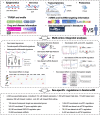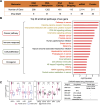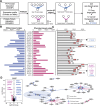SexAnnoDB, a knowledgebase of sex-specific regulations from multi-omics data of human cancers
- PMID: 39175079
- PMCID: PMC11342657
- DOI: 10.1186/s13293-024-00638-8
SexAnnoDB, a knowledgebase of sex-specific regulations from multi-omics data of human cancers
Abstract
Background: Sexual differences across molecular levels profoundly impact cancer biology and outcomes. Patient gender significantly influences drug responses, with divergent reactions between men and women to the same drugs. Despite databases on sex differences in human tissues, understanding regulations of sex disparities in cancer is limited. These resources lack detailed mechanistic studies on sex-biased molecules.
Methods: In this study, we conducted a comprehensive examination of molecular distinctions and regulatory networks across 27 cancer types, delving into sex-biased effects. Our analyses encompassed sex-biased competitive endogenous RNA networks, regulatory networks involving sex-biased RNA binding protein-exon skipping events, sex-biased transcription factor-gene regulatory networks, as well as sex-biased expression quantitative trait loci, sex-biased expression quantitative trait methylation, sex-biased splicing quantitative trait loci, and the identification of sex-biased cancer therapeutic drug target genes. All findings from these analyses are accessible on SexAnnoDB ( https://ccsm.uth.edu/SexAnnoDB/ ).
Results: From these analyses, we defined 126 cancer therapeutic target sex-associated genes. Among them, 9 genes showed sex-biased at both the mRNA and protein levels. Specifically, S100A9 was the target of five drugs, of which calcium has been approved by the FDA for the treatment of colon and rectal cancers. Transcription factor (TF)-gene regulatory network analysis suggested that four TFs in the SARC male group targeted S100A9 and upregulated the expression of S100A9 in these patients. Promoter region methylation status was only associated with S100A9 expression in KIRP female patients. Hypermethylation inhibited S100A9 expression and was responsible for the downregulation of S100A9 in these female patients.
Conclusions: Comprehensive network and association analyses indicated that the sex differences at the transcriptome level were partially the result of corresponding sex-biased epigenetic and genetic molecules. Overall, SexAnnoDB offers a discipline-specific search platform that could potentially assist basic experimental researchers or physicians in developing personalized treatment plans.
Keywords: Cancer; Multi-omics; Sex difference; Sex-biased regulatory network.
Plain language summary
Sexual variations at the molecular level have a profound impact on cancer biology and outcomes, influencing drug responses that diverge between men and women exposed to the same drugs. Despite existing databases on sex differences in human tissues, our understanding of the regulations governing sex disparities in cancer is limited, lacking detailed mechanistic studies on sex-biased molecules. This study addresses this gap by conducting a comprehensive examination of molecular distinctions and regulatory networks across 27 cancer types, specifically focusing on sex-biased effects. The analyses led to the identification of 126 cancer therapeutic target sex-associated genes and shed light on the intricate relationship between sexual differences and cancer. Furthermore, the findings from these analyses are made accessible through SexAnnoDB, providing a specialized search platform. This platform has the potential to assist basic experimental researchers or physicians in developing personalized treatment plans based on a deeper understanding of sex-specific factors in cancer.
© 2024. The Author(s).
Conflict of interest statement
The authors declare that they have no competing interests.
Figures








References
-
- Schmetzer O, Flörcken A. Sex differences in the drug therapy for oncologic diseases. Sex and gender differences in pharmacology. 2013:411 – 42. - PubMed
MeSH terms
Grants and funding
LinkOut - more resources
Full Text Sources
Medical
Miscellaneous

